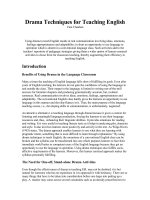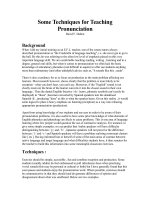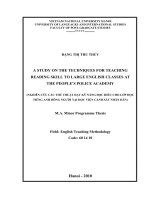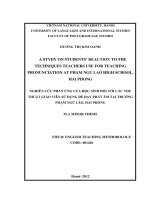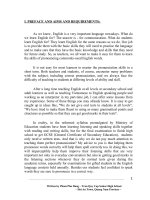Some Techniques for Teaching Pronunciation
Bạn đang xem bản rút gọn của tài liệu. Xem và tải ngay bản đầy đủ của tài liệu tại đây (80.59 KB, 4 trang )
Some Techniques for Teaching
Pronunciation
David F. Dalton
Background
When I did my initial training as an E.F.L. teacher, one of the course tutors always
described pronunciation as "the Cinderella of language teaching", i.e. she never got to go to
the ball. By this he was referring to the often low level of emphasis placed on this very
important language skill. We are comfortable teaching reading, writing , listening and to a
degree, general oral skills, but when it comes to pronunciation we often lack the basic
knowledge of articulatory phonetics (not difficult to aquire) to offer our students anything
more than rudimentary (and often unhelpful) advice such as, "it sounds like this ; uuuh".
There is also a tendency for us to focus on production as the main problem affecting our
learners. Most research however, shows clearly that the problem is more likely to be
reception - what you don't hear, you can't say. Moreover, if the "English" sound is not
clearly received, the brain of the learner converts it into the closest sound in their own
language . Thus the dental English fricative / th / (sorry, phonetic symbols can't easily be
displayed) in "those" ,becomes converted by Spanish speakers into the denatlised
Spanish /d/ , producing "dose" as this is what the speaker hears. Given this reality , it would
seem logical to place a heavy emphasis on listening (reception) as a way into releasing
appropriate pronunciation (production).
Apart from using knowledge of our students and our ears in order to be aware of their
pronunciation problems, it is also useful to have some prior knowledge of what elements of
English phonetics and phonology are likely to cause problems. This is one area of language
learning where few people would question the use of contrastive analysis. For instance, to
give some simple examples, we can predict that Arabic speakers will have difficulty
distinguishing between / p / and / b / , Japanese speakers will not perceive the difference
between / l / and / r / and Spanish speakers will hava a problem realising consonant clusters
like [ sts ]. Having informed him or herself of some of the main areas of contrast between
native language and target language and what difficulties students have, it then remains for
the teacher to build this information into some meaningful classroom exercises.
Techniques :
Exercise should be simple, accessible , fun and combine reception and production. Some
students (usually adults) do feel embarassed to pull ridiculuous faces when practising
vowel sounds (this may be personal or cultural or both) but I have generally found that this
soon passes and students enjoy the pronunciation work. Where possible, exercises should
be communicative in that they should (and do generate differences of opinion and
disagreement about what was said/heard. Below are two examples.
Exercise A :
After having taught or exposed the students to long and short vowels through listening and
oral work, the teacher can check recognition, retention and ability to discriminate in the
following way. This could also be used simply for teaching.
Stage 1 :
The teacher writes a variety of words containing the target sounds (long and short vowels)
on the board. The following is just one possible set.
PORT PIT PAT PERT PET POT PUTT PUT PART PEAT
0 1 2 3 4 5 6 7 8 9
Here, the only difference in sound is that of the vowel - familiar to anyone who has done
minimal pair work. As in these examples, the word should begin and end with the same
consonant. 0, 3, 8, and 9, are long vowels and the rest are short.
Stage 2 :
The teacher then models each word and individal repetition follows. The vowel sound can
be isolated and the procedure repeated until the teacher is reasonably sure that there are no
major problems. He or she then tells the students that they are going to hear one of the
words and must write the number which corresponds to the word they hear. What the
students have written is then checked and compared.
This automatically leads into a discussion of what they heard and what sounds they are
confusing. If student X heard1 when the teacher said 9, they are confusing the short vowel /
I / with the long vowel / i: / . The teacher gives feedback and the sounds may then be
modelled again and practised.
Stage 3:
Two or three words are then presented together and the procedure repeated. The teacher
then tells the class they are going to hear six words and that the numbers correspond to an
important telephone number. The teacher delivers the words and asks , "What's my
number?". Again there will be differences in what was heard. This allows a focus on which
sounds are not being discriminated effectively by which students and where their problems
lie. Later discussion may revolve aroud what strategies students may employ to improve
their discrimination skills - songs, minimal pair games with friends, movies, radio, etc.
Stage 4:
Learners are then invited to model the telephone number. This stage usually generates
much discussion and disagreement along the lines of - "You said ...... ", "No I did'nt ", "Say
it again" and so on and is usually very lively. The teacher is, of course, the final arbiter of
what was really said. The important thing is that the learners are thinking actively about
their pronunciation and how to repair it if necessary. They also begin to hear themselves
(often for the first time) and this is of immeasurable importance in the retention of sounds.
Exercise B:
This exercise was designed for a multi-lingual class, but is equally effective with
monolingual groups. It is more communictive in nature than Excercise A as it involves
giving and carrying out instructions.
Stage 1:
Having identified some problem areas for the class, the teacher makes a list of instructions
containing these. Below is such a list.
1. Draw a sheep on the board. (Spanish speakers often draw a ship).
2. Write the letter "P" above the sheep. (Arabic speakers often write " B").
3. Use the "P" as the start of the word "pleasant" and write the word (Japanese
speakers often write "present ").
4. Write "light" next to pleasant. (Japanese speakers often write "right").
5. Draw a mouse next to the word "light". (Spanish and Japenese speakers often draw
a mouth)
6. Draw a pear next to the mouse. (Arabic speakers often draw a bear)
Other examples can be added.
Stage 2:
After presentation and practice of the problem areas, each student is given a piece of paper
with an instruction containing such sounds. The papers are given so that a student will hear
an instruction containing a sound which they have a problem hearing. The instruction is
then whispered in the ear of the receiving student and they carry out what they hear. They
sit down and read their instruction to the next student. This continues until all the
instructions have been carried out and there is something resembling a picture on the board.
No comments should be made as the work is in process.
Stage 3: Feedback
There will be reactions from laughter to dismay as the students see how ther instructions
were carried out. The teacher needs to focus the students on what went wrong. Was the
problem production or reception? What did Miko say and what did Joel hear? The dilema
pushes the students to correct themselves and hear what they are saying. The discussions
are often very animated and again the teacher must abitrate. The learners also see the real-
life consequences of not producing or not hearing appropriate English sounds as well as
getting personal and class feedback on their problem areas. As in exercise A, discussion
can take place on strategies for pronunciation.
Some Conclusions
1. The exercise allows clear practice in production and reception and gives concise
feedback to individual learners as to where their problms lie in these areas and how
to repair them. Often these are very simple physical questions such as not roundig
the lips as in / u: / in fool , which the teacher can help them focus on.
2. This, in turn, allows discussion on learning strategies for pronunciation which can
be drawn up it the classroom.
3. It is a communicative exercise as it involves disagreement, repair and ( hopefully !)
agreement among other things.
4. Many language learners feel self concious and negative about their pronunciation .
To effectively deal with this question in the class and enable learners to see an
improvement, is invariably a great psychological boost.
5. I have used these activities with learners from many different cultural and language
backgrounds and they have invariably been seen as both very useful and fun.
6. As teachers, we are often not the best judges of the accuracy of our students'
pronunciation . We are accustomed to it and usually very tolerant when in general,
native speakers are not. Such exercises help us to be more aware of real problems
learners have in their oral production and to help to correct them.
7. Such activities should be an integral part of any language teaching programme as
they make pronunciation an active element of the learning process and focus
learners on the language they are producing.
Thanks to Ray Parker of Sheffield Hallam University; England for the gelephone Game.
Some useful and very accessible constrastive analysis can be seen in the " Ship or Sheep"
and "Three or Tree" series.
